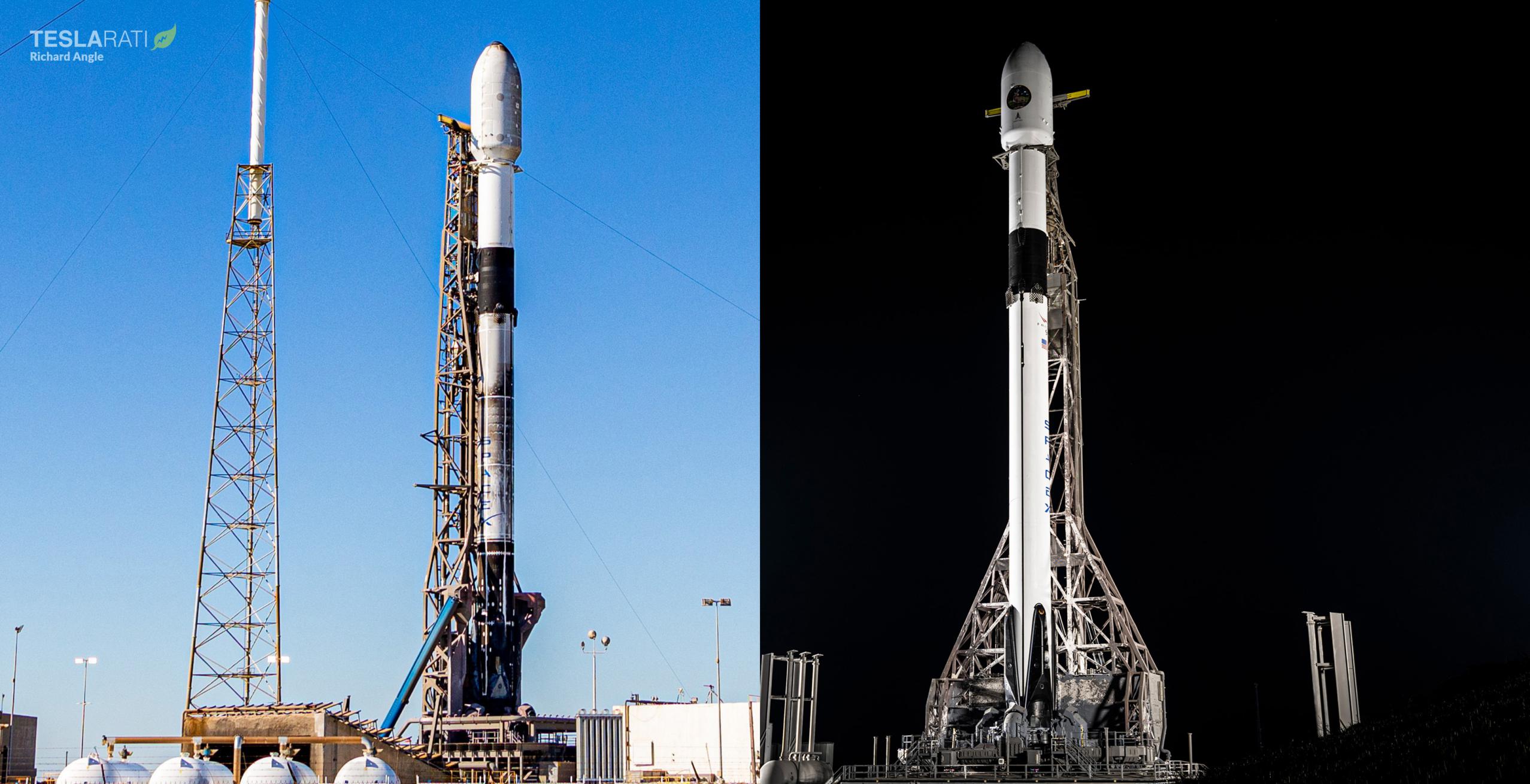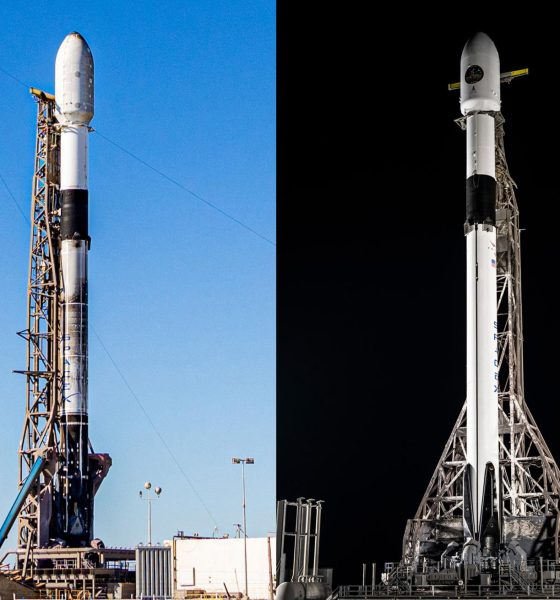

News
SpaceX preparing for back-to-back Starlink launches from California and Florida
Update: Next Spaceflight reports that SpaceX has delayed Starlink 4-15 to 4:38 pm EDT, May 14th, ending the immediate possibility of a new SpaceX record for time between launches.
After a few days of delays pushed the missions closer together, SpaceX is now preparing to launch two batches of 53 Starlink satellites just eight hours apart – one from Florida and the other from California.
Originally scheduled to launch as early May 10th, which would have tied SpaceX’s Vandenberg Space Force Base (VSFB) SLC-4E launch pad turnaround record, Starlink 4-13 slipped to May 12th within the last few days. 2400 miles (~3900 km) to the east, SpaceX’s Starlink 4-15 mission – preparing to launch from the company’s Cape Canaveral Space Force Station (CCSFS) LC-40 pad – recently found itself in the opposite boat.
On April 22nd, Spaceflight Now reported that Starlink 4-15 was scheduled to launch no earlier than (NET) May 8th. At the time, Starlink 4-13 was also scheduled to launch on the 8th, placing the two Starlink missions just a few hours apart. On April 28th, Spaceflight Now updated its well-sourced launch calendar, revealing that Starlink 4-13 had slipped to May 10th and Starlink 4-15 to May 16th, ending their concurrence. Finally, on May 7th and May 8th, photographer Ben Cooper reported that Starlink 4-15 had moved up to 2:08 am EDT (06:08 UTC), May 13th and FAA documents revealed that Starlink 4-13 had slipped again to 3:29 pm PDT (22:29 UTC), May 12th.
In other words, the missions have again found themselves just a handful of hours apart after weeks of unrelated juggling and delays. Barring additional issues, Starlink 4-13 and Starlink 4-15 are scheduled to launch just 7 hours and 41 minutes apart. Set in late 2021, the shortest time between two Falcon launches is currently 15 hours and 17 minutes. But above all else, the constant back and forth – only to end up with both launches again just hours apart – demonstrates just how agonizing and unforgiving the planning behind every rocket launch schedule truly is.
Fittingly, Starlink 4-13’s drone ship headed to sea just ~60 hours before the scheduled launch and Starlink 4-15’s drone ship has yet to depart, keeping the launch dates of both missions about as uncertain as they can be without guaranteeing that delays are coming. Both drone ships must be towed about 400 miles downrange at speeds that almost never exceed 8-10 mph, translating to a minimum two-day journey even with zero stops, slowdowns, or detours.
Beyond the record-breaking potential, Starlink 4-13 is an otherwise ordinary mission that will launch another 53 Starlink V1.5 satellites to an ordinary 53.2-degree inclination, which simply means that they’ll end up in the same ‘shell’ as the other satellites in Starlink’s ‘Group 4’ shell. Despite launching from the opposite coast of the US, Starlink 4-15 will be almost identical and is expected to deploy another 53 Starlink V1.5 satellites to the same orbital shell. However, it appears that Starlink 4-15 will have a few highly unusual features.
Instead of performing a hockey stick-like ‘dogleg’ maneuver to avoid overflying any populated islands in the Bahamas, Falcon 9 will directly overfly the country’s largest western island and attempt to land right in the middle of the archipelago, potentially touching down on a drone ship just 5-15 miles away from Nassau and a couple other islands. The fact alone that SpaceX was able to convince both the Bahamas and the US’ FAA to allow it to fly the trajectory shown above is extremely impressive and belies a deep trust in SpaceX’s expertise and Falcon 9’s safety and reliability. At the same time, SpaceX may be taking some degree of risk, as the trajectory’s minuscule margins for error probably mean that Falcon 9’s automatic flight termination system will be programmed to destroy the rocket at the slightest hint of deviation from the planned trajectory.
Adding to the oddity, Starlink 4-15 will be the first in a long line of 45 dedicated Starlink launches to debut a new Falcon 9 booster. According to Next Spaceflight, Falcon 9 B1073 will claim that unusual first, almost entirely flipping the table on the precedent of conservative government customers – still timid about SpaceX reusability – scrambling to secure increasingly rare launch opportunities on new Falcon 9 boosters. Alternatively, it’s possible – but unlikely – that SpaceX implemented significant changes to Falcon 9 B1073 that it wants to verify independently before risking customer payloads.
With any luck, the new rocket will perform flawlessly and give some nearby Bahamians a truly one-of-a-kind experience: the ability to watch a SpaceX Falcon 9 booster land at sea… from the comfort of their own homes.

News
Elon Musk’s Grok AI to be used in U.S. War Department’s bespoke AI platform
The partnership aims to provide advanced capabilities to 3 million military and civilian personnel.

The U.S. Department of War announced Monday an agreement with Elon Musk’s xAI to embed the company’s frontier artificial intelligence systems, powered by the Grok family of models, into the department’s bespoke AI platform GenAI.mil.
The partnership aims to provide advanced capabilities to 3 million military and civilian personnel, with initial deployment targeted for early 2026 at Impact Level 5 (IL5) for secure handling of Controlled Unclassified Information.
xAI Integration
As noted by the War Department’s press release, GenAI.mil, its bespoke AI platform, will gain xAI for the Government’s suite of tools, which enable real-time global insights from the X platform for “decisive information advantage.” The rollout builds on xAI’s July launch of products for U.S. government customers, including federal, state, local, and national security use cases.
“Targeted for initial deployment in early 2026, this integration will allow all military and civilian personnel to use xAI’s capabilities at Impact Level 5 (IL5), enabling the secure handling of Controlled Unclassified Information (CUI) in daily workflows. Users will also gain access to real‑time global insights from the X platform, providing War Department personnel with a decisive information advantage,” the Department of War wrote in a press release.
Strategic advantages
The deal marks another step in the Department of War’s efforts to use cutting-edge AI in its operations. xAI, for its part, highlighted that its tools can support administrative tasks at the federal, state and local levels, as well as “critical mission use cases” at the front line of military operations.
“The War Department will continue scaling an AI ecosystem built for speed, security, and decision superiority. Newly IL5-certified capabilities will empower every aspect of the Department’s workforce, turning AI into a daily operational asset. This announcement marks another milestone in America’s AI revolution, and the War Department is driving that momentum forward,” the War Department noted.
News
Tesla FSD (Supervised) v14.2.2 starts rolling out
The update focuses on smoother real-world performance, better obstacle awareness, and precise end-of-trip routing, among other improvements.

Tesla has started rolling out Full Self-Driving (Supervised) v14.2.2, bringing further refinements to its most advanced driver-assist system. The new FSD update focuses on smoother real-world performance, better obstacle awareness, and precise end-of-trip routing, among other improvements.
Key FSD v14.2.2 improvements
As noted by Not a Tesla App, FSD v14.2.2 upgrades the vision encoder neural network with higher resolution features, enhancing detection of emergency vehicles, road obstacles, and human gestures. New Arrival Options let users select preferred drop-off styles, such as Parking Lot, Street, Driveway, Parking Garage, or Curbside, with the navigation pin automatically adjusting to the user’s ideal spot for precision.
Other additions include pulling over for emergency vehicles, real-time vision-based detours for blocked roads, improved gate and debris handling, and extreme Speed Profiles for customized driving styles. Reliability gains cover fault recovery, residue alerts on the windshield, and automatic narrow-field camera washing for new 2026 Model Y units.
FSD v14.2.2 also boosts unprotected turns, lane changes, cut-ins, and school bus scenarios, among other things. Tesla also noted that users’ FSD statistics will be saved under Controls > Autopilot, which should help drivers easily view how much they are using FSD in their daily drives.
Key FSD v14.2.2 release notes
Full Self-Driving (Supervised) v14.2.2 includes:
- Upgraded the neural network vision encoder, leveraging higher resolution features to further improve scenarios like handling emergency vehicles, obstacles on the road, and human gestures.
- Added Arrival Options for you to select where FSD should park: in a Parking Lot, on the Street, in a Driveway, in a Parking Garage, or at the Curbside.
- Added handling to pull over or yield for emergency vehicles (e.g. police cars, fire trucks, ambulances).
- Added navigation and routing into the vision-based neural network for real-time handling of blocked roads and detours.
- Added additional Speed Profile to further customize driving style preference.
- Improved handling for static and dynamic gates.
- Improved offsetting for road debris (e.g. tires, tree branches, boxes).
- Improve handling of several scenarios, including unprotected turns, lane changes, vehicle cut-ins, and school buses.
- Improved FSD’s ability to manage system faults and recover smoothly from degraded operation for enhanced reliability.
- Added alerting for residue build-up on interior windshield that may impact front camera visibility. If affected, visit Service for cleaning!
- Added automatic narrow field washing to provide rapid and efficient front camera self-cleaning, and optimize aerodynamics wash at higher vehicle speed.
- Camera visibility can lead to increased attention monitoring sensitivity.
Upcoming Improvements:
- Overall smoothness and sentience.
- Parking spot selection and parking quality.
News
Tesla is not sparing any expense in ensuring the Cybercab is safe
Images shared by the longtime watcher showed 16 Cybercab prototypes parked near Giga Texas’ dedicated crash test facility.

The Tesla Cybercab could very well be the safest taxi on the road when it is released and deployed for public use. This was, at least, hinted at by the intensive safety tests that Tesla seems to be putting the autonomous two-seater through at its Giga Texas crash test facility.
Intensive crash tests
As per recent images from longtime Giga Texas watcher and drone operator Joe Tegtmeyer, Tesla seems to be very busy crash testing Cybercab units. Images shared by the longtime watcher showed 16 Cybercab prototypes parked near Giga Texas’ dedicated crash test facility just before the holidays.
Tegtmeyer’s aerial photos showed the prototypes clustered outside the factory’s testing building. Some uncovered Cybercabs showed notable damage and one even had its airbags engaged. With Cybercab production expected to start in about 130 days, it appears that Tesla is very busy ensuring that its autonomous two-seater ends up becoming the safest taxi on public roads.
Prioritizing safety
With no human driver controls, the Cybercab demands exceptional active and passive safety systems to protect occupants in any scenario. Considering Tesla’s reputation, it is then understandable that the company seems to be sparing no expense in ensuring that the Cybercab is as safe as possible.
Tesla’s focus on safety was recently highlighted when the Cybertruck achieved a Top Safety Pick+ rating from the Insurance Institute for Highway Safety (IIHS). This was a notable victory for the Cybertruck as critics have long claimed that the vehicle will be one of, if not the, most unsafe truck on the road due to its appearance. The vehicle’s Top Safety Pick+ rating, if any, simply proved that Tesla never neglects to make its cars as safe as possible, and that definitely includes the Cybercab.








